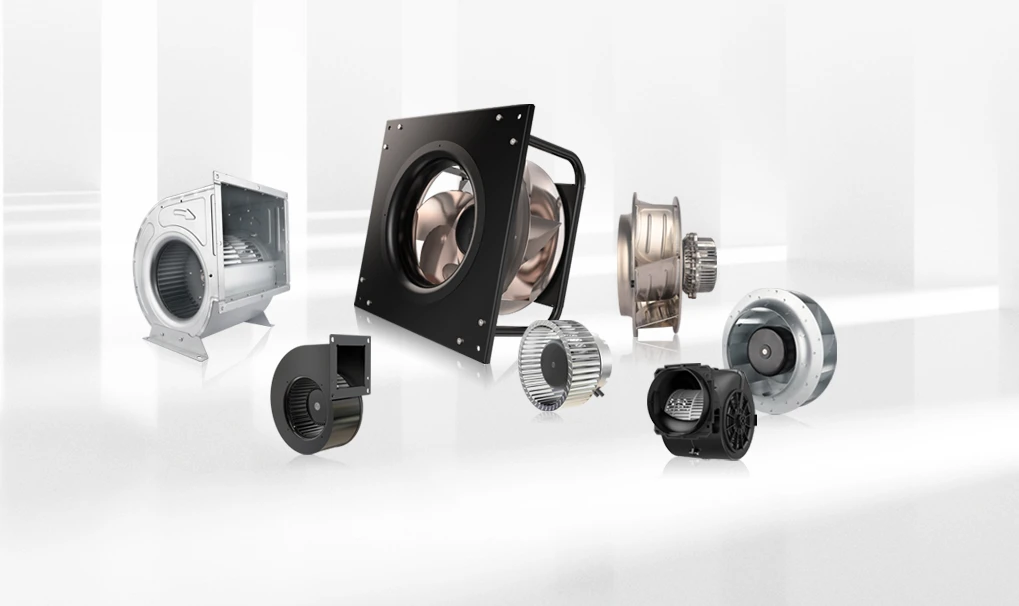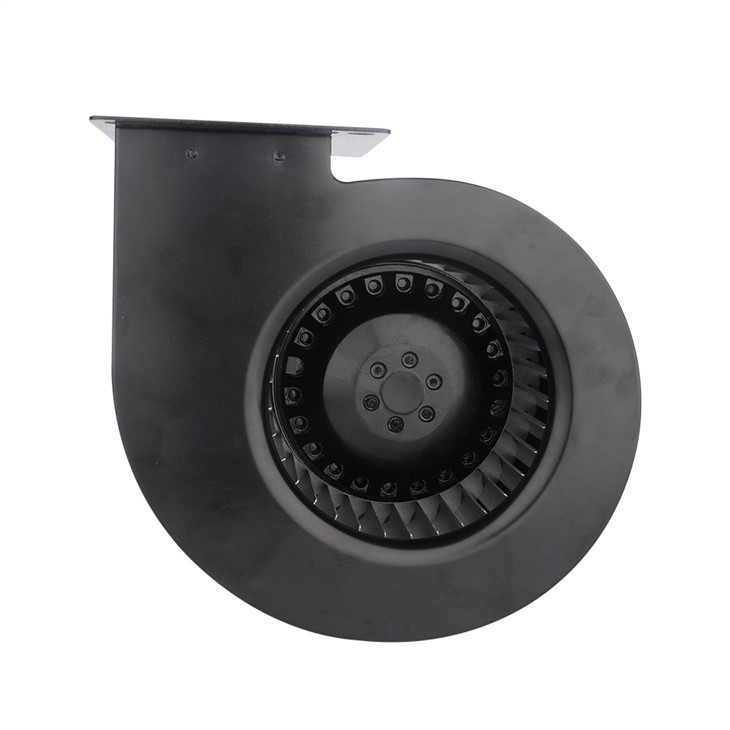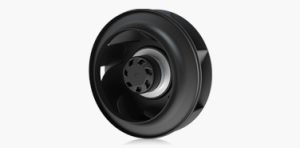
Introduction
Centrifugal fans are a very adaptable type of fan. They are used a lot in homes, businesses, and industrial applications. Unlike axial fans, which push air in a straight line, centrifugal fans use a spinning impeller. This design pulls air in and then pushes it out to the side. This special way of moving air helps centrifugal fans create higher air pressure, making them suitable for applications requiring low pressure. Because of this, they work well for many tasks like ventilation, cooling, and material handling.
The Basics of Centrifugal Fans
Centrifugal fans work based on a simple idea: centrifugal force. When the fan’s impeller spins, it pulls air in through the inlet. This air then moves outwards because of the centrifugal force from the spinning impeller, which speeds it up.
The fast-moving air goes through the fan housing and exits through the outlet. The fan housing and ductwork push back against the air that flows out, creating static pressure. This ability to create more static pressure sets centrifugal fans apart from axial fans. It also makes them useful for many different purposes.
The Principle of Centrifugal Force in Fan Technology
At the center of every centrifugal fan is the idea of centrifugal force. This force is important for how the fan moves air and creates pressure. To understand how these fans work well, you need to know about centrifugal force and fan technology.
When the radial wheel, which is called the impeller, spins quickly, it gives energy to the air that gets pulled into the fan. This air is then pushed outwards, away from the center, because of centrifugal force.
The fan housing is key in guiding this air that moves outward. By directing the airflow toward the outlet, the housing turns the energy from the air into static pressure. This ongoing process creates a steady stream of pressurized air for different uses.
Key Components of a Centrifugal Fan
A centrifugal fan has several important parts that work together to move air and create pressure effectively. The electric motor is a key component. It powers the rotation of the impeller. The power rating of the motor is very important. It affects how much air the fan can move and how much pressure it can create.
The impeller, which is also called the fan wheel, is connected to the motor shaft. It usually has several fan blades that are specially designed to improve air movement and save energy. The shape, size, and angle of these blades can greatly affect how well the fan works.
The fan housing surrounds these parts. It is carefully made to control the incoming air and airflow. The housing helps direct the air that the impeller pulls in and pushes it toward the outlet. This improves airflow and reduces energy waste. The size, shape, and design of the housing are made for the specific use and the airflow needs.
The Various Types of Centrifugal Fans
Centrifugal fans come in different types. They are not just one type that works for everything. Each kind has different blade shapes and designs. This leads to different airflow patterns and pressure levels.
This range helps engineers and designers pick the best fan for their needs. They can improve efficiency and performance for certain situations. Let’s check out some common types of centrifugal fans.
Forward Curved Fans: Design and Applications

Forward curved fans are easy to spot. Their blades curve in the direction they spin. These fans have a small size and can move a lot of air at lower pressures. This feature makes them great for places where you need a lot of air but do not require high static pressure.
You can often see forward curved fans in HVAC systems. They help move air quietly through ductwork, filters, and coils. These fans are used as blower fans for furnaces and air handlers in homes and businesses.
Here’s a quick look at where forward curved fans are used:
- Residential and commercial HVAC systems: They provide good airflow for heating, ventilation, and air conditioning.
- Fan coil units: They circulate air in rooms or zones in buildings.
- Air handling units: They deliver conditioned air in larger buildings.
Backward Inclined Fans: Efficiency and Use Cases

Backward inclined fans are named because their blades curve the opposite way of how the impeller rotates. They offer a good mix of efficiency, quiet running, and being cost-effective, consuming less power. These fans are perfect for situations where higher static pressure and efficiency are needed, which is more than what forward curved fans provide.
A key feature of backward inclined fans is their power curve that does not overload. This means the motor does not need more power if the system resistance goes down. This safety trait, along with their high efficiency, often leads to lower daily costs.
These fans are used in many areas, like:
- Industrial applications: Such as ventilating factories, workshops, and processing plants.
- Commercial HVAC systems: Acting as main air movers in big buildings.
- Drying and curing ovens: Providing steady airflow for various industrial tasks.
Radial Blade Fans: Durability and Industrial Uses
Radial blade fans have blades that go straight out from the middle of the radial bladed wheel. They are built tough and can handle tough jobs in many industries. These fans work well in places with dust, debris, or harmful materials, showing they can face hard conditions.
The straight blade design makes cleaning and service easy, which helps keep downtime low. Radial blade fans are great at creating high pressure, making them perfect for industrial blowers and moving materials, especially in higher temperatures.
Here are some common uses for these strong fans:
- Dust collection systems: They work well to clear dust and debris from woodworking shops and factories.
- Pneumatic material handling: They transfer materials like sawdust, grains, and powders.
- Combustion air supply: They give a steady airflow for industrial burners and furnaces.
Fans: High Efficiency and Low Noise Solutions
Airfoil fans are a special type of backward inclined fans. They use airfoil-shaped blades, which help them save energy and operate quietly. These blades look like airplane wings. This design helps the fans create more air pressure while causing less turbulence. This means they waste less energy and make less noise.
People really like airfoil fans because they can move a lot of air while keeping noise levels very low and ensuring low power consumption. They are often used in places where noise matters a lot. These fans are great for places that need both energy savings and quiet environments.
You can find these high-quality fans in certain spaces:
- Hospitals: for keeping areas clean and quiet for patients.
- Schools and offices: for providing comfortable airflow without distracting people.
- Theaters and auditoriums: for quiet and effective ventilation in performance areas.
The Significance of Fan Blade Design
The shape of fan blades is very important for how a centrifugal fan works. It affects how well the fan moves air and creates the right static pressure. There are three main types of blade designs: forward curved, backward inclined, and flat single thickness radial. Each type influences the airflow, pressure, noise level, and energy use of the fan.
When you choose a centrifugal fan for your needs, it’s key to understand these different blade designs. Depending on whether you need high static pressure, a certain airflow, less noise, or better energy efficiency, picking the right fan blade design is essential. This way, you can make sure the fan meets your requirements.
Impact of Blade Design on Performance
The way a centrifugal fan’s blades are designed greatly affects how well it works. Things like fan speed, how efficient it is, and the shape of the performance curve depend on how the blades interact with air flowing through the fan.
For example, forward curved blades are made to push large volumes of air at lower speeds. This makes them good for places where quiet operation is very important, even in handling air containing small amounts of corrosive materials. However, they usually have lower static efficiency than backward inclined blades.
Backward inclined blades are better for higher speeds and can create more static pressure. This leads to better energy efficiency. Their performance curve often shows a non-overloading feature, which helps with safety during operation. Radial blades are strong and can handle higher pressure needs, but they may be louder than other types.
Material Considerations for Longevity and Resistance
Choosing the right material for your centrifugal fan blades is very important. It affects how long the blades last, how well they resist corrosion, and how durable they are.
Steel is strong and is a common choice for fan blades in tough industrial environments. Stainless steel provides even better corrosion resistance. This makes it a great option for places with moisture or harsh chemicals.
For lighter tasks, aluminum or composite materials are good options. They are cost-effective while still providing decent performance. When picking a material, think about the conditions where you’ll use the fan. This will help you get the best performance and lifespan from the fan blades.
Installation and Maintenance Best Practices
Installing and taking care of a centrifugal fan is very important for its best performance and longer life. When a fan is installed correctly, it works well, uses less energy, and is less likely to break down early.
Right maintenance also keeps the airflow steady and helps the fan run at its best for a longer time. By following some easy tips for installation and maintenance, you can really improve how well your centrifugal fan works and how long it lasts.
Essential Steps for Proper Fan Installation
A good installation of a centrifugal fan starts with knowing the manufacturer’s guidelines. Review these instructions carefully before you begin. It is important to mount the fan securely. This helps reduce vibration and noise when the fan is running.
Think about the drive system. Direct drive systems usually offer lower cost and need less maintenance than belt-driven systems. The Air Movement and Control Association (AMCA) offers helpful information and standards for fan installations. They guide you on ductwork sizing, airflow, and other important factors.
Here are important points to focus on during installation:
- Secure mounting: Make sure the fan is firmly placed on a stable platform to reduce vibration.
- Proper ductwork sizing: Follow the recommended sizes for ductwork to improve airflow and efficiency.
- Electrical connections: Check that all electrical connections meet safety rules and the manufacturer’s guidelines.
Routine Maintenance to Ensure Optimal Performance
To keep your centrifugal fan working well for a long time, you need a regular maintenance routine. Checking it often can help you find and fix problems early, which saves you money on repairs and downtime.
One important part of maintenance is making sure the fan blades stay clean and free of dirt or anything else. You should also check the fan housing for signs of damage, especially in industrial applications where the conditions can be tough. If it applies, lubricating the bearings as told by the manufacturer will help keep things running smoothly and reduce friction.
Here’s a simple checklist for your maintenance plan:
- Regular cleaning: Check and clean the fan blades, housing, and motor often to stop dust from building up.
- Bearing lubrication: Lubricate bearings like the manufacturer says to cut down on friction and wear.
- Vibration monitoring: Keep an eye on vibration levels sometimes to spot any problems with bearings or alignment.
Real-World Applications of Centrifugal Fans
Centrifugal fans are very important in many industries and uses. They are good at moving large volumes of air, creating higher pressure, and working well in tough conditions. This makes them necessary in different fields.
Centrifugal fans are key in residential and commercial HVAC systems. They also play an important role in industrial ventilation and material handling. These fans help keep spaces comfortable and safe while also helping with different industrial tasks. Let’s look at some main uses in more detail.
HVAC Systems: Enhancing Air Quality and Comfort
Centrifugal fans are essential for many HVAC systems. They help keep air quality high and indoor spaces comfortable. By moving and spreading treated air, these fans create a nice and healthy environment in homes, offices, and other areas.
These fans have different uses in HVAC systems. They can be found in air handling units that manage air in large buildings. They can also be in smaller fan coil units that control temperature in individual rooms. Besides moving air, some HVAC systems use centrifugal fans to remove stale air and bring in fresh air.
Here’s a summary of their roles in HVAC systems:
- Air circulation: Making sure temperatures are comfortable and even in a room.
- Ventilation: Bringing in fresh air and getting rid of stale air to improve indoor air quality.
- Filtration: Helping to filter out airborne particles and other pollutants.
Industrial Processes: Ventilation and Cooling Needs
Centrifugal fans are very important in many industrial processes. They help with ventilation, cooling, and moving materials. These industrial fans are built strong, so they work well in tough environments. This makes them perfect for factories, manufacturing plants, and processing facilities.
Centrifugal fans provide necessary ventilation in factories where there is a lot of heat or contaminants in the air. They also supply cool air to machines and equipment, serving as an integral part of effective air filtration systems. This helps keep the industrial space safe and efficient. In industries that use pneumatic systems to transport materials like grains, powders, or sawdust, these fans are also essential.
Common uses for these fans include:
- Industrial ventilation: Taking away fumes, dust, and other harmful particles from work areas.
- Process cooling: Giving cool air to keep the temperature steady for industrial equipment and processes.
- Material handling: Moving materials with pneumatic systems in different industries.
Conclusion
In conclusion, it is important to understand the different kinds of centrifugal fans, particularly for clean air applications. This knowledge helps you choose the right one for your needs. There are several types, like forward curved, backward inclined, radial blade, and airfoil fans. Each type has its own benefits in design, efficiency, and use. The design of fan blades is very important. Also, proper installation and maintenance are key for the best performance and lifespan. These fans are used in many places, from HVAC systems to industrial processes. They are versatile and necessary in many situations. If you want more help choosing the right fan, check out our complete selection to make a good choice.
Frequently Asked Questions
How do I choose the right centrifugal fan for my needs?
Choosing the right centrifugal fan is important for your needs. You should think about your specific applications and how you will use it. Consider things like the airflow (CFM) you need, the static pressure, the size you have space for, and how much noise is okay for you. This will help you find the best type and size of the fan.
What are the main differences between axial and centrifugal fans?
Axial fans push air straight along their rotation axis. This action leads to a drop in pressure. On the other hand, centrifugal fans pull air inwards and send it outwards, creating higher pressure. The way each fan moves air and changes pressure shows where they can be used best.

